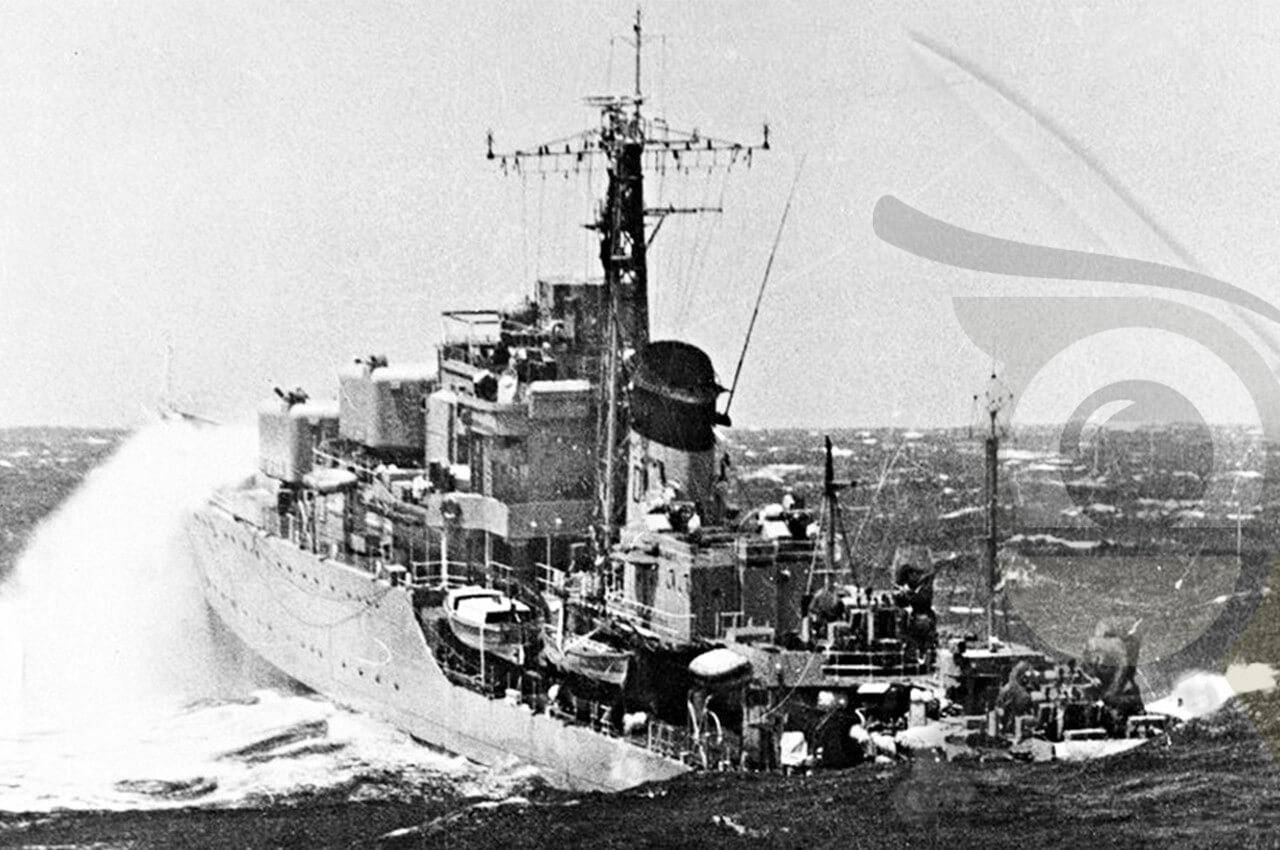6 SEP 1951: The Korean War and HMAS ANZAC bombs targets near Haeju. HMAS ANZAC was detached from HMS Glory’s screen to bombard targets near Haeju, Korea. The ANZAC was one of 11 Australian ships to serve in Korea. HMAS ANZAC (D59) was a Battle class destroyer of the Royal Australian Navy.
Named after the Australian and New Zealand Army Corps, the destroyer was commissioned in 1951. The ship served on two tours of duty during the Korean War, and attempts to distinguish herself from British ships led to the practice of red kangaroo symbols on Australian warships.
During 1956, ANZAC served during the Malayan Emergency. In 1960, a malfunction in the destroyer’s gun direction equipment caused ANZAC to fire directly on sister ship HMAS Tobruk during a gunnery exercise, with Tobruk left unrepairable. In 1961, the destroyer was reclassified as a training vessel. ANZAC remained in service until 1974, and was sold for breaking a year later.
ANZAC was built to the British Battle class destroyer design. The ship had a displacement of 2,436 tons as designed, although this displacement increased to 3,450 tons after her 1963 reclassification as a training ship.
She was 379 feet (116 m) long overall and 355 feet (108 m) long between perpendiculars, with a beam of 41 feet (12 m), and a draught of 21 feet 11.5 inches (6.693 m). Propulsion was provided by two Admiralty 3-drum boilers supplying steam to Parsons geared turbines; these generated 50,000 shaft horsepower for the destroyer’s two propeller shafts. ANZAC was designed to reach 31.5 knots (58.3 km/h; 36.2 mph), but could usually only reach 31 knots (57 km/h; 36 mph).
The ship’s company originally consisted of 320 personnel, but after conversion into a training ship, this changed to 169 ship’s company plus 109 trainees.
The main armament of ANZAC consisted of four 4.5-inch Mark VI guns in two twin turrets. This was supplemented by twelve Bofors 40 mm guns for air defence, (three twin mountings and six single mountings, a Squid anti-submarine mortar, and two sets of 5-tube 21-inch Pentad torpedo launchers.
On 30 July 1951, ANZAC left Australian waters for her first deployment to the Korean War. Arriving in Japan on 14 August, the destroyer was assigned as an escort to the United States Navy (USN) escort carrier USS Sicily and operated off the west coast of Korea.
Sicily was replaced by the Royal Navy (RN) light carrier HMS Glory on 2 September, and on 6 September, ANZAC was ordered to shell a suspected communist position near Haeju, and fired in anger for the first time at 18:15. During 12–26 September, ANZAC led US Ships Thompson and Naifeh in a blockade of Wosan, before returning to Japanese waters at the end of the month.
Her first Korean tour completed, ANZAC escorted HMS Glory to Sydney, where they arrived on 20 October. The destroyer then proceeded to Melbourne for a refit, which lasted until the end of 1951, and remained in Australian waters until deploying with the cruiser HMAS Australia in April 1952 for a training cruise through Maritime Southeast Asia.
After undergoing another, brief refit, ANZAC rejoined the Korean War effort, and spent most of September patrolling the west coast of Korea, then joined the escort screen of the RN light carrier Ocean at the start of October. After a short break in Kure, the destroyer was assigned to patrols and shore bombardments on the west coast until 19 December, when she relieved HMCS Haida and assumed responsibility for the defence of Yongdo Island.
Herself relieved on 3 January 1953, ANZAC returned to the west coast of Korea, where she resumed patrols and bombardments. Apart from a brief stint on the east coast shelling supply lines and a visit to Tokyo to celebrate the coronation of Queen Elizabeth II, ANZAC operated off the west coast until 13 June; the conclusion of her second Korean tour. ANZAC arrived in Sydney on 3 July.
For her two tours, ANZAC was awarded the battle honour “Korea 1951–53”. During these tours, the ship’s company often found themselves mistaken for British warships, as the RAN ensign at the time was identical to the British White Ensign, and the Battle class was a British design.
To counteract this, the executive officer acquired the largest sheet of brass he could find, and had the kangaroo design from the reverse of the Australian penny cut from the sheet, which was then mounted to the top of the mainmast as a ‘weathervane’. This method of identification was later adopted across the RAN: all major fleet units now bear a red kangaroo symbol on each side of their exhaust funnels or superstructure. Photo: HMAS ANZAC in rough waters. More; http://ow.ly/RPQZo



